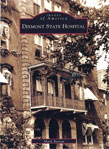Who were the Laughlins?
This article appeared in the October 2014 issue of Signals in conjunction with a program by David N. McKnight entitled "James Laughlin IV and the New Directions Publishing Company."
The Laughlin name is well known in the Sewickley Valley, but it is important to note that there are several different families involved. Let us distinguish among them.
First of all, who was James Laughlin IV, the subject of our lecture this month?
The great-grandfather of James Laughlin IV, James Laughlin I (1806-1882), was a partner of Benjamin Franklin Jones (1826-1903) in the famous firm, Jones & Laughlin Steel. Laughlin was born in Ireland and remained there until age twenty, when, after the death of his mother, he and his father emigrated to America and joined his elder brother Alexander (1790-1867), who had come to Pittsburgh in 1819. Upon arrival, James entered into a partnership with his brother Alexander in a provisioning and pork packing house in Pittsburgh and Evansville, Indiana. This partnership was dissolved in 1835, and James continued in business with a new partner.
In 1837, James married Ann McCully Irwin (1813-1892), and they had a daughter and four sons: Henry A. (1838-1922), Irwin B. (1840-1871), George A. (1842-1908), Elizabeth Irwin (1844-1929) and James II (1847-1919). James Laughlin I was one of the organizers of the Fifth Avenue Savings Bank, later called the Pittsburgh Trust Company and, later, the First National Bank of Pittsburgh, which was the first national bank in Allegheny County. James Laughlin I became President of that bank.
In the 1850s, James Laughlin I retired from the provision business and turned his attention to the manufacture of iron. Benjamin Franklin Jones was partners with Bernard and John Lauth in a small mill in Pittsburgh called the American Iron Works. In 1854, Laughlin joined the group and bought out the Lauths’ interests. In 1861, James Laughlin I and his sons Henry and Irwin and B. F. Jones and his brothers, George and Thomas, formed the firm of Jones & Laughlin, which would later use Lake Superior ore and Connellsville coal to make the finest iron and steel.
James Laughlin II, fourth son of James Laughlin I and Ann Irwin, married Sidney Page (1848-1925). They had sons named James Laughlin III and Henry Hughart Laughlin. Henry Hughart Laughlin married Marjorie Rea, and they were the parents of James Laughlin IV, named after his uncle, James Laughlin III.
Who, then, was Alexander Laughlin, Jr. (1844-1881), who married the eldest daughter of B. F. Jones, and who, with his family, became the second generation of the Joneses to live at Franklin Farm, the family estate on Sewickley Heights?
Benjamin Franklin Jones married Mary McMasters (1829-1911) on May 21, 1850, and they had four children: Mary Franklin (1851-1931), Elizabeth McMasters (1862-1939), Alice (1866-1939) and Benjamin Franklin Jones, Jr. (1868-1928). Mary married Alexander Laughlin, Jr., in the 1860s. He was the son of James Laughlin’s brother Alexander Laughlin (1790-1867), mentioned above, and his wife, Mary Ann Bailey. Therefore, this Alexander Laughlin, Jr., was the nephew of B. F. Jones’ partner in the steel business, James Laughlin.
Finally, who were the Alexander Laughlins who lived where the Sewickley Academy faculty housing is located today in a house called Linganore; who constructed a handsome library in Ambridge, Pennsylvania, in memory of their son, Alexander Laughlin, Jr.; and who were instrumental in the founding of the institution today known as the Mary and Alexander Laughlin Children’s Center, located in Sewickley?
This Alexander Laughlin was born in 1866 in Wheeling, West Virginia, son of Alexander and Lisette Lamping Laughlin. He was educated in Wheeling schools, the Hill School and attended Washington and Jefferson College. In 1883, he began his career as a clerk at the Laughlin Nail Company of Wheeling, later working at the Junction Iron Company, also in Wheeling.
In 1887, he married Mary Bushnell Mead, and they had one son, Alexander Laughlin, Jr. (1889-1926). In that same year, Laughlin decided to go into business for himself and came to Pittsburgh, where he engaged in the design and construction of furnaces in iron and steel mills, trading as Alexander Laughlin & Company. His firm went on to design and build many of the largest steel plants in the United States.
In 1904, Laughlin purchased the Pittsburgh Steel Construction Company in Allegheny, Pennsylvania, and shortly thereafter purchased land in Economy (later Ambridge), where he built a modern structural steel plant. This operation was discontinued in 1909 and sold to the Central Tube Company, which had been organized by Mr. Laughlin. In time, five pipe mills would be constructed in Ambridge. He was also later involved with the Verona Tool Works.
The Laughlins moved to Sewickley in 1891, not long after their arrival in Pittsburgh. Mrs. Laughlin founded the Sewickley Fresh Air Home in 1901, a structure consisting of twenty five rooms on Big Sewickley Creek Road in Fair Oaks intended to provide “for needy children from Pittsburgh’s tenement neighborhoods,” with an emphasis on “fresh air, nourishing food and plenty of healthy exercise.” Later, the home served crippled and convalescent children. The Fresh Air Home continued to offer services into the 1950s. When Mary Mead Laughlin died in 1953, leaving money for the continued support of children’s services, the home was combined with the Child Counseling Center of Sewickley Valley (sponsored by the Child health Association of Sewickley) to form the Laughlin Children’s Center, which opened in 1956.

